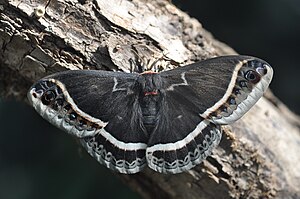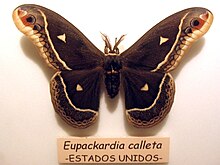Eupackardia calleta
| Eupackardia calleta | ||||||||||||
|---|---|---|---|---|---|---|---|---|---|---|---|---|

Eupackardia calleta |
||||||||||||
| Systematics | ||||||||||||
|
||||||||||||
| Scientific name of the genus | ||||||||||||
| Eupackardia | ||||||||||||
| Cockerell , 1912 | ||||||||||||
| Scientific name of the species | ||||||||||||
| Eupackardia calleta | ||||||||||||
| ( Westwood , 1853) |
Eupackardia calleta is a butterfly and the only species of the genus Eupackardia from the family of the peacock moth (Saturniidae). The species is common in Mexico and the extreme southwest of the United States of America. Both the moths and the caterpillars differ somewhat from one another both in their appearance and in their way of life or in the habitats they inhabit. However, it is the same species and a division into several species or subspecies is apparently not justified.
features
butterfly
The moths reach a forewing length of 41 to 57 millimeters (males) or 52 to 60 millimeters (females). The animals have a black base color with a conspicuous postmedial band and a subapical spot, which make the species unmistakable. They have a certain resemblance to the males of Callosamia promethea ; however, this species usually has no postmedial band and no discal spots, or these features are at most pale. Females have significantly more rounded wings and wider postmedial bars than males. The white anterior medial line is also usually much stronger in the females. The species is very variable and even in relatively small occurrences in the United States of America, depending on the population, but also within the same population in size, wing shape and pattern. So much so that some authors split up the three populations found in the United States of America. Crossing experiments show, however, that the division into different species or subspecies does not seem justified.
Caterpillar
The caterpillars are 75 to 80 millimeters long and are conspicuous, probably colored in warning colors. With increasing age, they have longitudinal rows of appendages (scoli), similar to those of the genera Rothschildia and Hyalophora , but these are of the same size, as in the latter genus. Texas animals have a slate green base color and blue scoli on the sides and back. These are surrounded by a conspicuous black ring near the orange or yellow base. Within a colony there are animals with an orange or yellow base of the scoli in a ratio of 1: 1. Around Ajo, the caterpillars have a light green basic color and also blue scoli, which are, however, somewhat smaller and slimmer than in other populations. In addition, the black rings on the scoli are severely receded or missing completely. The base is colored red. In the south of Arizona the caterpillars have a striking ocean blue base color. The strong scoli are conspicuously black and their base is strong coral red. The extent of the black pattern on the animals varies depending on the individual.
Occurrence
The species is distributed from Mexico to the extreme southwest of the United States of America. You can find them there in Texas in the Rio Grande Valley and in Big Bend Country . Further west they are also found in the extreme south of Arizona. The species colonizes various habitats such as bushy plains up to slopes and canyons in middle mountain locations between 1000 and 1500 meters to a maximum of 2100 meters around the Mexican border, with its lush vegetation due to the summer rains. However, very hot and dry desert habitats are also populated, such as around Ajo and the Organ Pipe Cactus National Monument .
Way of life
The adults hatch in the late evening and only become sexually active the following morning. In Arizona, for example, females begin around 7:30 a.m., and a little later in Texas, attracting the males with pheromones. The males are active until shortly after noon. Mating lasts until dusk, during which time the females begin to lay eggs. As with the moths of the genus Rothschildia, the moths open their wings when they are at rest.
Flight and caterpillar times
The moths and caterpillars occur in the north of their range at different times of the year. In South Texas, the moths fly from September to early November and in a second generation in early spring. Adults and adult caterpillars can be found there in March and until the end of April. In Arizona, the species flies in only one generation per year, with the moths flying in mountain locations during the summer rains in July and August and in the desert areas, including Mexico, flying in late autumn and winter during the cooler season with some rainfall. For example, the animals fly around Ajo from the beginning of October to mid-January. These changed flight times are an adaptation to the high temperatures there during the summer months, which are survived in the pupal stage .
Food plants of the caterpillars
The caterpillars in Texas feed mainly on Leucophyllum frutescens , but also on ash trees ( Fraxinus ). Around Ajo, the caterpillars have been found on Sapium biloculare , in southeast Arizona they mainly feed on Fouquieria splendens , but there are also individual records of caterpillars on willows ( Salix ) and Tecoma stans .
development
The females lay their chalk-white eggs in small groups on the top and bottom of the leaves of the host plants. In the beginning the caterpillars live socially, later they are loners. You go through five stages. In the last stage, they often feed sitting freely on the plants. If they are disturbed, they secrete a transparent liquid from their enlarged tubercles on the back, which contains poisonous amines and scares off predatory mammals, but is less effective with other predators. Like the moths, the caterpillars differ geographically in their way of life.
The cocoon is usually spun close to the ground in the shade of the food plant or close to it on a short stalk. Like Rothschildia lebeau, the animals spin the cocoon directly around them and do not use any additional built-in leaves for stabilization. The hatch opening is only spun late, which is why the caterpillars can be easily observed while spinning the cocoon.
Taxonomy and systematics
The species is probably related to the genus Rothschildia and the group, which includes the genera Callosamia and Hyalophora . The wing veins of all four genera are very similar. The genitals are similar to those of the genus Rothschildia .
supporting documents
Individual evidence
- ↑ a b c d e f g h i j k P. M. Tuskes, JP Tuttle, MM Collins: The Wild Silkmoths of North America. A Natural History of the Saturniidae of the United States and Canada . Ed .: George C. Eickwort. 1st edition. Cornell University Press, Ithaca / London 1996, ISBN 0-8014-3130-1 , pp. 191 ff . (English).
- ↑ The Global Lepidoptera Names Index - Agapema ( page no longer available , search in web archives ) Info: The link was automatically marked as defective. Please check the link according to the instructions and then remove this notice.
literature
- PM Tuskes, JP Tuttle, MM Collins: The Wild Silkmoths of North America. A Natural History of the Saturniidae of the United States and Canada . Ed .: George C. Eickwort. 1st edition. Cornell University Press, Ithaca / London 1996, ISBN 0-8014-3130-1 (English).
Web links
- Lepidoptera and some other lifeforms (English)
